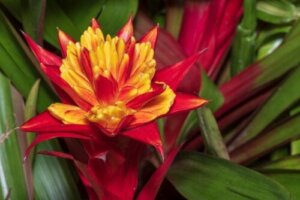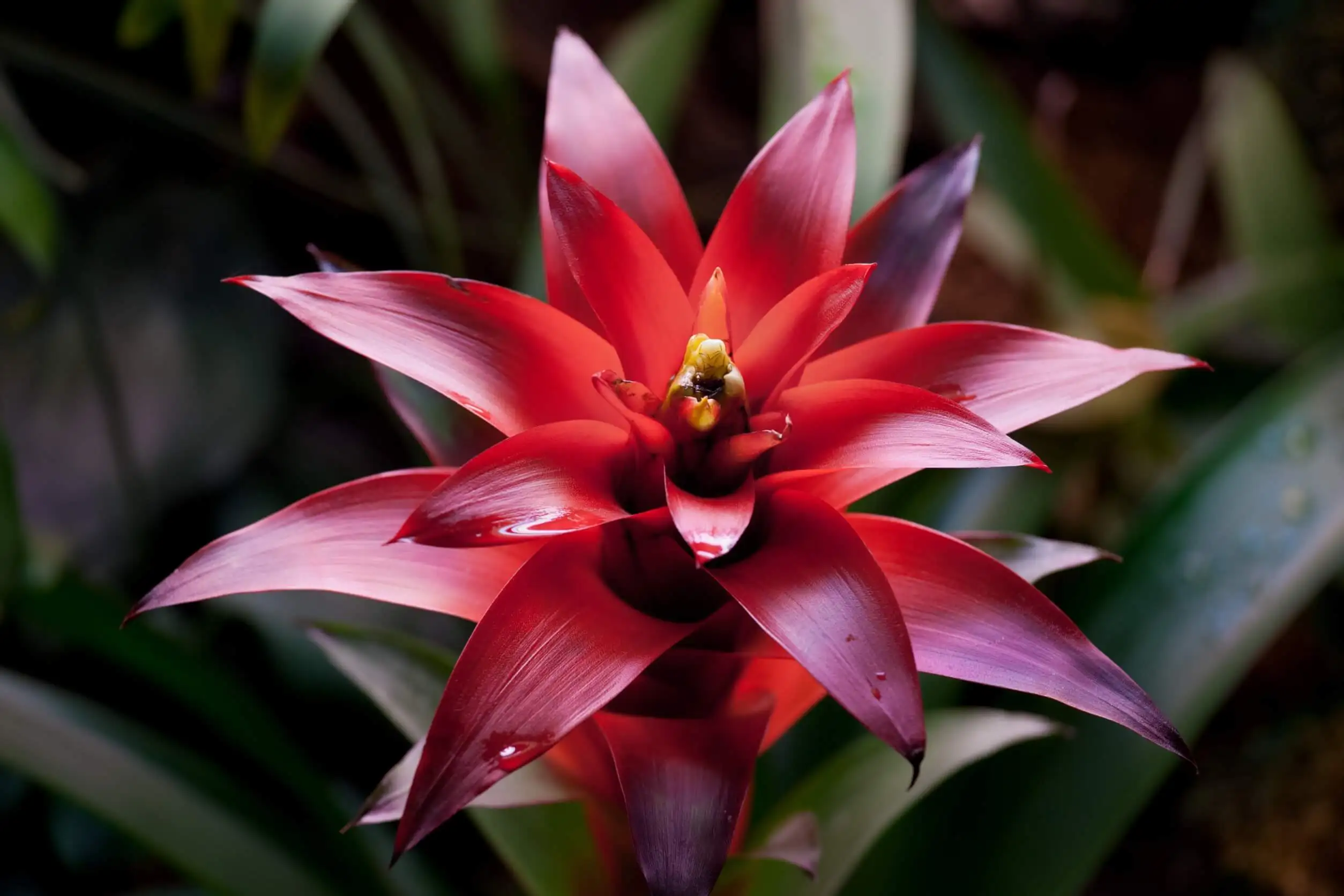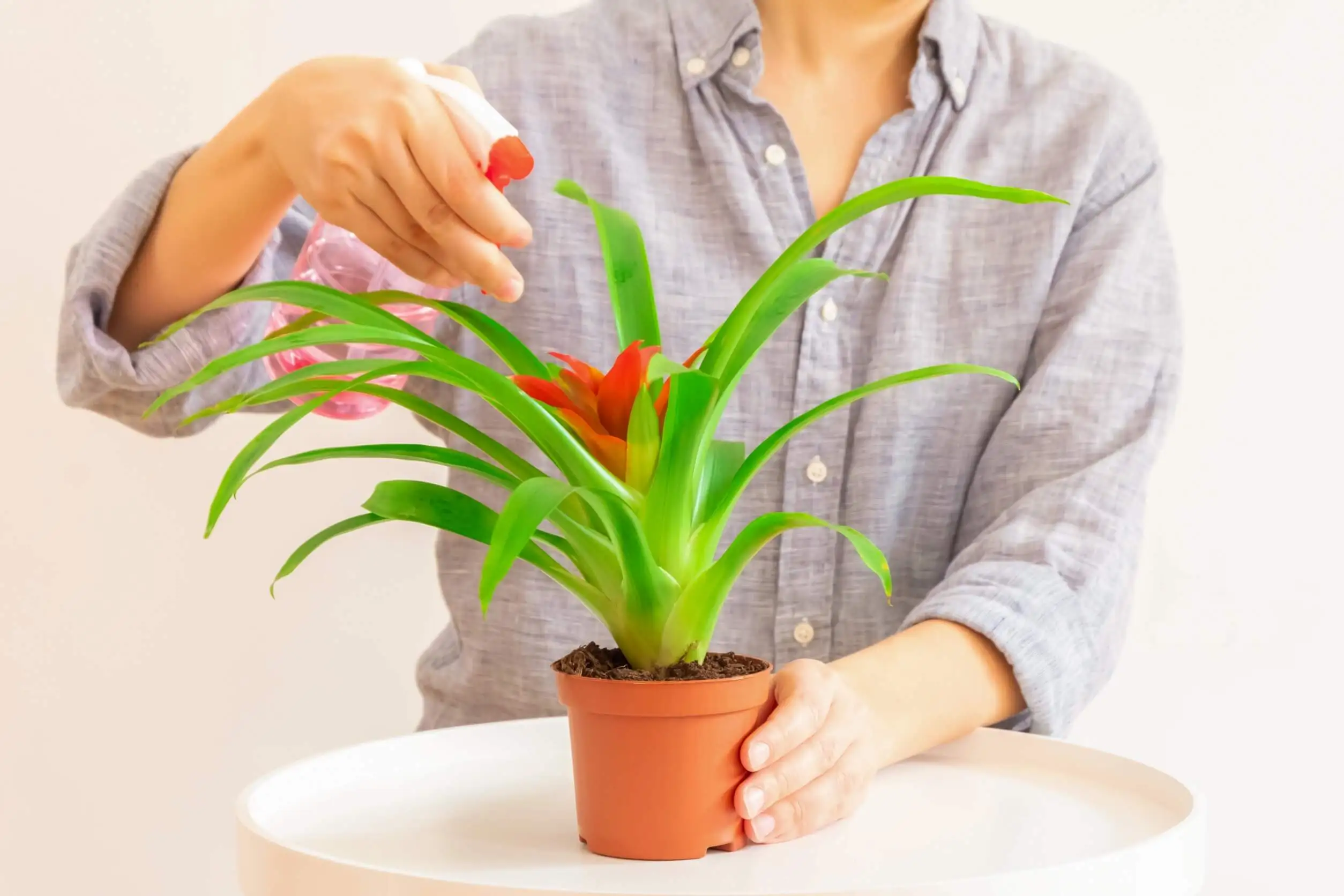How to Grow Bromeliads: Care and Recommendations

At first glance, growing bromeliads seems like a difficult task. However, these tropical-looking plants are easy to plant, require little maintenance, and are resistant to various climatic and environmental conditions.
With the scientific name Bromeliaceae genera, this is an epiphyte that brings eye-catching colors to the indoor garden. It’s noted for its beautiful foliage, with leaves varying in shades of red, green, orange, purple, and yellow.
As such, it does not require soil to grow. It can cling to trees or other objects and can be planted in shallow soil. What care is required and where should it be planted? Here are all the details.
The main characteristics of bromeliads
Bromeliads are perennial plants belonging to the Bromeliaceae family. They’re native to West Africa, but are currently distributed in North America, South America, and Central America. It’s estimated that there are about two thousand species, although the genera Guzmania, Neoregelia, and Vriesea are the best known.
As noted in a publication in Ecology and Evolution, these plants are slow-growing and tend to prefer habitats with high rainfall and humidity. They take about three years to mature and flower, although some species require more time.

Although these plants are epiphytes – because they tend to grow on the bark of trees in jungle areas – they are also cultivated for ornamental purposes. They are usually small in size, although they can reach up to one meter in height.
They have lanceolate leaves whose tones vary according to the genus. Some have green colors, but others vary from pink to purple and gray. In addition, their flowers have intense and vivid colors, which can vary from red to fuchsia, orange or pink.
It should be noted that bromeliads only bloom once during their lifespan. After this, it’s necessary to cut the flower stem from its base for the plant to generate offshoots.
Types of bromeliads
As we have mentioned, there are more than two thousand species of bromeliads. Most of them are epiphytes and are found in their native distribution areas, that is, the tropical regions of America. Even so, there are common species that can be cultivated in gardens. The most popular are the following:
- Guzmania: This includes the most common species, such as G. lingulata, G. zahnii, G. Guzmania sanguinea and G. monostachia. They usually have long, flat, bright green leaves. Their flowers may appear bright red, yellow, orange, pink, or purple, depending on the species.
- Neoregelia: This is a very diverse genus of bromeliads. They are especially used as houseplants, as their leaves are quite showy, with colors ranging from pink to purple.
- Vriesea: The V. bromeliad is characterized by its variegated foliage and feather-like flowers. It includes popular species such as V. splendens and the hybrid Vreisea ‘Fireworks’.
- Ananas comosus: This is the genus that includes the common pineapple. It has spidery leaves and a flower spike on which miniature pineapples grow.
We think you may be interested in reading this, too: How to Make a Moss Guide or Support for Climbing Plants
Care and recommendations to grow bromeliads
The first thing to keep in mind when growing bromeliads is that they do not require thick or too deep of soil, but quite the opposite. In gardening, mixtures of bark, moss, or other organic materials are often used. Also, a shallow pot is the best option.
Of course, some specific conditions must be created for the plant to mature and flourish. This can be determined by light, temperature, humidity, and feeding. In general, they do not require too much maintenance and adapt well in tropical, warm, and temperate climates.
It’s possible to grow bromeliads without soil. To do this, the plant must be attached to an object that allows it to stand upright.
Light to grow Bromeliads
When growing bromeliads, keep in mind to provide them with bright, indirect light, especially if they have hard, rigid leaves. If they are soft-leaved, spineless varieties, light levels should be a bit lower.
Soil
When it comes to growing indoor bromeliads, the ideal soil is usually made with two-thirds peat-based soil and one-third sand. This allows for moisture retention, but also ensures drainage. Other mixtures are charcoal, mosses, and soils for orchids.
While some prefer to plant them in shallow pots, there are those who mount them on logs, boards, and similar surfaces. In the latter cases, its necessary to have a support for the plant.
Water

One of the reasons this plant is considered hardy is because it can withstand drought conditions. Although its natural environment is humid, it does not require much watering. In fact, in their growth stage, they should be watered sparingly on a weekly basis. In the winter, watering should be reduced.
The root of the plant is sensitive to rot, so no water should remain stagnant. The key is to wait until the soil surface feels dry to the touch before watering again. On the other hand, it’s a good idea to spray the leaves with the help of a spray bottle.
Temperature and humidity
Bromeliads often prefer temperatures between 60 and 85 degrees Fahrenheit. They tend not to tolerate very cold temperatures, so they require protection in the winter.
Although some can withstand environments as low as 20°F, they should not be exposed to environments below 40°F. The recommended humidity for their growth is between 40 and 50%.
Fertilizer
One of the great advantages of growing bromeliads is that they usually do not require fertilizer. Often, the plant does well on its own with watering. However, liquid fertilizer diluted by half can be applied during the growth stage. If the plant is close to flowering, using these products may be counterproductive.
Outdoor cultivation
Some special considerations are necessary if you want to grow bromeliads outdoors. It’s best to opt for shallow pots, since in winter, it’s better to move them indoors to prevent them from rotting.
It’s also possible to grow them under a shady tree or on any plant that manages to avoid direct contact with sunlight. Too much light tends to burn the leaves. Watering should not be ignored, as too much humidity will deteriorate the plant. Make sure there is good drainage.
Pests
Bromeliads are unlikely to be attacked by pests. Most of the time they develop diseases due to excessive watering or excessive exposure to direct sunlight.
Propagation
The usual way to propagate bromeliads is from their buds. Cultivation from seed is usually more difficult. In any case, if the latter option is chosen, it’s advisable to do so during the winter.
Like this article? You may also like to read: We Recommend 6 Succulent Plants to Decorate Your Home
What to remember when growing bromeliads
Because of their striking colorful flowers, bromeliads are often preferred as houseplants or garden plants. They’re slow growing and may take about three years before flowering. Once in bloom, the parent plant usually dies. However, it grows back from its buds.
In general, little care is required to keep it in top condition. Moderate watering and indirect light are key. Also, it’s a good idea to plant them in small pots, with a good drainage system, that can be taken indoors during the winter. So, are you going to give this plant a try?
All cited sources were thoroughly reviewed by our team to ensure their quality, reliability, currency, and validity. The bibliography of this article was considered reliable and of academic or scientific accuracy.
- Ladino G, Ospina-Bautista F, Estévez Varón J, Jerabkova L, Kratina P. Ecosystem services provided by bromeliad plants: A systematic review. Ecol Evol. 2019 May 29;9(12):7360-7372. doi: 10.1002/ece3.5296. PMID: 31380056; PMCID: PMC6662323.
- Cach-Pérez MJ, Andrade JL, Chilpa-Galván N, Tamayo-Chim M, Orellana R, Reyes-García C. Climatic and Structural Factors Influencing Epiphytic Bromeliad Community Assemblage along a Gradient of Water-Limited Environments in the Yucatan Peninsula, Mexico. Tropical Conservation Science. 2013;6(2):283-302. doi:10.1177/194008291300600209
- NCBI Taxonomy: a comprehensive update on curation, resources and tools. Database (Oxford). 2020: baaa062. PubMed: 32761142 PMC: PMC7408187.
- Bromeliads. University of Florida Institute of Food & Agricultural Sciences.
- Schiappacasse, Flavia, et al. Ethylene Spray Influences Flowering of the Chilean Bromeliad Fascicularia Bicolor. Idesia (Arica), 2016, pp. 0–0. doi:10.4067/S0718-34292016005000027
- Bromeliads. University of Wisconsin-Madison Extension.
This text is provided for informational purposes only and does not replace consultation with a professional. If in doubt, consult your specialist.








